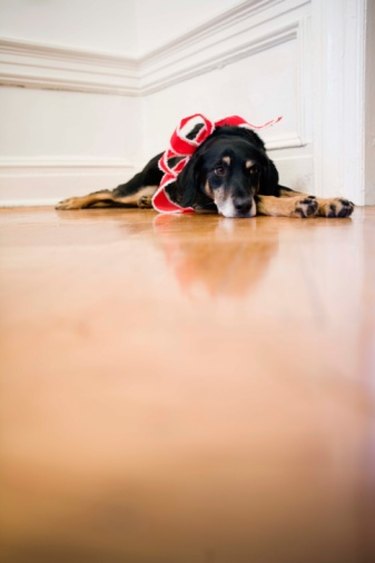
Once a concrete surface has been painted, resurfacing requires some time and effort. Solutions for resurfacing depend on project goals. If the goal is to achieve an entirely new, unblemished surface and look, complete removal of old paint is a must. If the goal is to improve and refresh a surface with full understanding that the painted concrete will need to be revisited and readdressed from time to time, a less thorough approach may suffice.
Grind, Polish and Reseal
Video of the Day
One enduring solution is to remove the old paint through grinding and polishing with the help of a drum sander. The machine enables the do-it-yourselfer to stand behind and push the grinding and polishing surface to remove paint and a fine top layer of concrete. Preparation of the surface includes getting rid of anything that could scratch the existing concrete, cleaning the surface to remove any dust, dirt or grease and allowing the surface to dry completely. Other preparatory steps are to use plastic sheeting to keep dust from filtering beyond the work area and to allow plenty of ventilation. Wearing protective gear such as goggles, gloves and mask to cover the nose is essential. The process removes paint with a grinding pad and sands the floor to a fine finish with ever finer sanding pads. Once the desired surface is achieved, the floor is ready for a sealer or stain.
Video of the Day
Acid Wash and Refinish
Over time, moisture rising under a painted concrete surface is likely to push upward and create bubbles. Additionally, high traffic areas on painted concrete floors can show wear. One commonly recommended paint stripping solution is a muriatic acid wash. The bottled liquid acid is usually available in the swimming pool supply section of home and garden centers. It is usually sold as a 31 percent solution by volume and should be diluted to 10 or 15 percent for concrete washing, using about 1 gallon for about 50 square feet. Protective heavy gloves and eye goggles should be worn. Avoid drainage into areas where plants may be damaged or pets or children will walk, and use only in well-ventilated areas. The acid wash loosens paint that does not fully adhered to the concrete surface. The concrete can be scraped or scrubbed with a brush to loosen more tightly adhering old paint. Once the acid is thoroughly rinsed away and the surface is completely dry, a fresh coat of paint or concrete stain can be applied. Techniques such as blending two to three colors by either spraying or rag painting are the most likely to disguise the resurfacing of new color treatment over any remaining old paint and to last a few seasons.
Tile, Stone or Cement Overlays
A different resurfacing solution is to completely cover the concrete. As long as an adhesive will adhere to the concrete, tile or stone can be applied. Similarly, a cement overlay system can go over the existing concrete. Some of these blend cement, sand, polymer resins and a number of additional additives that create an attractive and wear-resistant surface. The strength of the polymer-enhanced overlays is that they are damage resistant when exposed to chemicals, including salts, thawing and freezing conditions, exposure to ultraviolet rays and even abrasion. Their thickness can also be adjusted from credit card thin to a thickness of several inches.